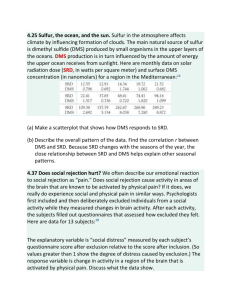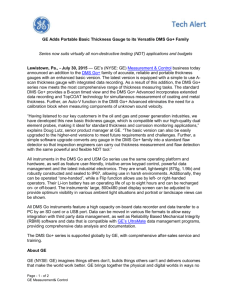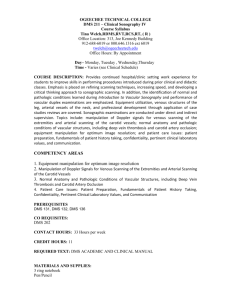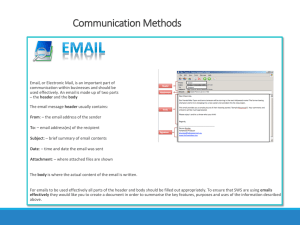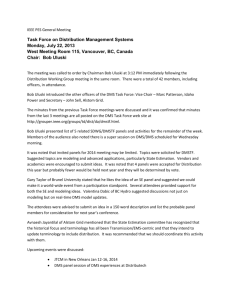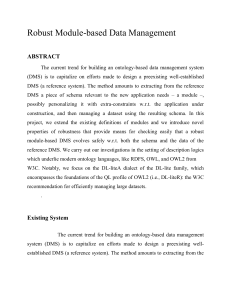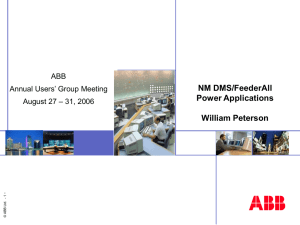A modern distribution management system for regional electricity
advertisement
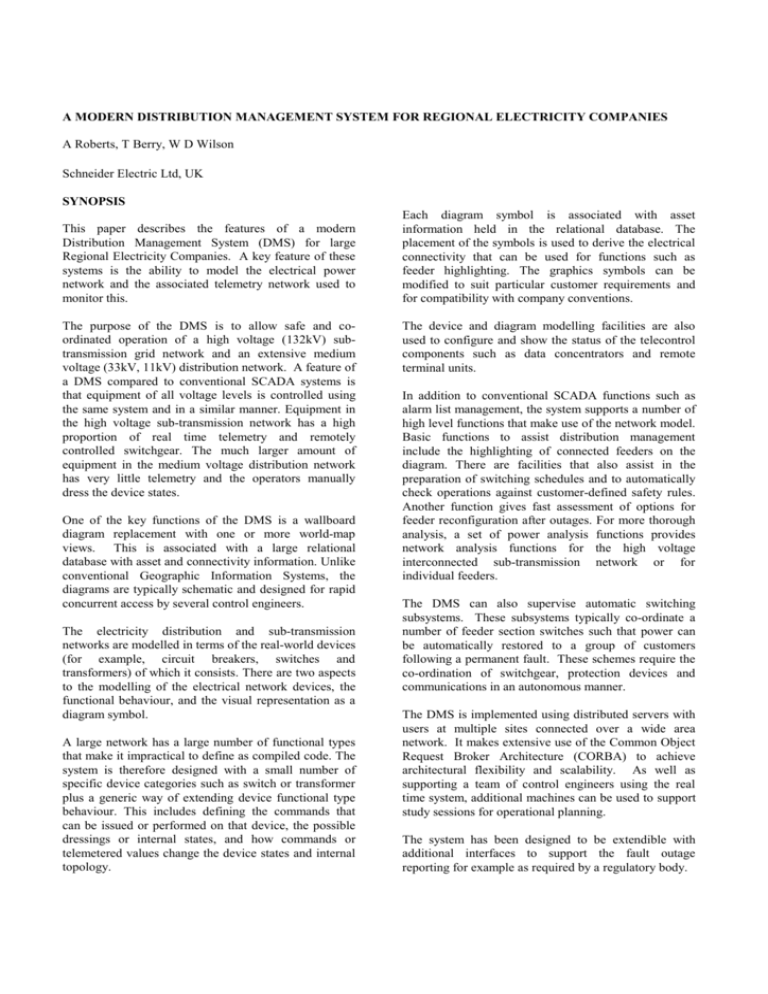
A MODERN DISTRIBUTION MANAGEMENT SYSTEM FOR REGIONAL ELECTRICITY COMPANIES A Roberts, T Berry, W D Wilson Schneider Electric Ltd, UK SYNOPSIS This paper describes the features of a modern Distribution Management System (DMS) for large Regional Electricity Companies. A key feature of these systems is the ability to model the electrical power network and the associated telemetry network used to monitor this. The purpose of the DMS is to allow safe and coordinated operation of a high voltage (132kV) subtransmission grid network and an extensive medium voltage (33kV, 11kV) distribution network. A feature of a DMS compared to conventional SCADA systems is that equipment of all voltage levels is controlled using the same system and in a similar manner. Equipment in the high voltage sub-transmission network has a high proportion of real time telemetry and remotely controlled switchgear. The much larger amount of equipment in the medium voltage distribution network has very little telemetry and the operators manually dress the device states. One of the key functions of the DMS is a wallboard diagram replacement with one or more world-map views. This is associated with a large relational database with asset and connectivity information. Unlike conventional Geographic Information Systems, the diagrams are typically schematic and designed for rapid concurrent access by several control engineers. The electricity distribution and sub-transmission networks are modelled in terms of the real-world devices (for example, circuit breakers, switches and transformers) of which it consists. There are two aspects to the modelling of the electrical network devices, the functional behaviour, and the visual representation as a diagram symbol. A large network has a large number of functional types that make it impractical to define as compiled code. The system is therefore designed with a small number of specific device categories such as switch or transformer plus a generic way of extending device functional type behaviour. This includes defining the commands that can be issued or performed on that device, the possible dressings or internal states, and how commands or telemetered values change the device states and internal topology. Each diagram symbol is associated with asset information held in the relational database. The placement of the symbols is used to derive the electrical connectivity that can be used for functions such as feeder highlighting. The graphics symbols can be modified to suit particular customer requirements and for compatibility with company conventions. The device and diagram modelling facilities are also used to configure and show the status of the telecontrol components such as data concentrators and remote terminal units. In addition to conventional SCADA functions such as alarm list management, the system supports a number of high level functions that make use of the network model. Basic functions to assist distribution management include the highlighting of connected feeders on the diagram. There are facilities that also assist in the preparation of switching schedules and to automatically check operations against customer-defined safety rules. Another function gives fast assessment of options for feeder reconfiguration after outages. For more thorough analysis, a set of power analysis functions provides network analysis functions for the high voltage interconnected sub-transmission network or for individual feeders. The DMS can also supervise automatic switching subsystems. These subsystems typically co-ordinate a number of feeder section switches such that power can be automatically restored to a group of customers following a permanent fault. These schemes require the co-ordination of switchgear, protection devices and communications in an autonomous manner. The DMS is implemented using distributed servers with users at multiple sites connected over a wide area network. It makes extensive use of the Common Object Request Broker Architecture (CORBA) to achieve architectural flexibility and scalability. As well as supporting a team of control engineers using the real time system, additional machines can be used to support study sessions for operational planning. The system has been designed to be extendible with additional interfaces to support the fault outage reporting for example as required by a regulatory body. A MODERN DISTRIBUTION MANAGEMENT SYSTEM FOR REGIONAL ELECTRICITY COMPANIES A Roberts, T Berry, W D Wilson Schneider Electric Ltd, UK INTRODUCTION This paper describes the features of a modern Distribution Management System (DMS) for large Regional Electricity Companies. A key feature of these systems is the ability to model the electrical power network and the associated telemetry network used to monitor this. A DMS is designed primarily for Network Operation and Operational Planning. These terms have been defined by a CIRED working group (1) and adopted by a draft IEC standard (2) as: Network Operation functions are “those functions which enable control and supervision of the distribution network facilities” and include control, monitoring, fault management and operating statistics. Operational Planning functions are “facilities to define, prepare and optimise the sequence of operations required for carrying out maintenance work on the system” and include network simulation and switch action scheduling. The primary purpose of a distribution management system for network operations is to enable the dispatch of field crew to maintain and repair the network, safely and promptly. The modern competitive market emphasises that utilities need to monitor and improve levels of customer satisfaction as well as optimising network operations and controlling operational costs. • • • A high voltage (132kV) grid which is a subtransmission meshed network connected to the UK 400kV Super Grid; A medium voltage (33kV) primary distribution network of mainly dual circuits; A medium voltage (11kV) distribution network consisting of 20,000 km of interconnected radial circuits and supplying approximately 2,000,000 customers. The majority of the 132kV and 33kV substations (about 350) are equipped with remote monitoring and control equipment connected to the control centre SCADA system. The much larger amount of equipment in the medium voltage (11kV) distribution network has a smaller percentage of telemetry. Operations on this distribution network are performed manually by field engineers acting under supervision of control engineers. The main tool used by the control engineers was a large wallboard diagram that could be manually dressed to show the device states as reported from the field. For all voltage levels, operations are co-ordinated using switching schedules and safety documents. Figure 1 shows the SCADA communications network and illustrates the geographical extent of the SEEBOARD area. Glossary CORBA DMS SCADA Common Object Request Broker Architecture Distribution Management System Supervisory Control And Data Acquisition Keywords Network operations, network management, distribution management systems. THE NETWORK The DMS has been supplied to SEEBOARD, one of the 12 Regional Electricity Companies in England and Wales. Some key features of the SEEBOARD distribution network include: Figure 1. SEEBOARD’s SCADA communication network BUSINESS OBJECTIVES Until recently, computer systems for distribution management have existed as ‘islands of automation’. Different systems have been bought and installed for remote control (SCADA), network analysis, plant and asset data and drawing office support. In addition, to manage the size and complexity of distribution networks, it has been common practice to separate the network operations and planning functions by voltage level as well as by geographic region. Apart from a desire to replace and upgrade existing SCADA systems, the business objectives for a modern DMS include the following: • Introduction of an integrated system with both high voltage sub-transmission networks and medium distribution feeders. This helps to optimise operations requiring the co-ordination of field crew working at different voltage levels. • Integration of power network diagrams, plant data and telemetry network data regardless of voltage level or mode of control (remote or manual). This aims to reduce the overhead of data entry into multiple databases and the problems due to inconsistencies between them. • Integration of power analysis tools for planning and optimisation studies. • Provision of interfaces to fault management, customer information, asset and map management systems. • Collection of reporting information for regulatory purposes. USER REQUIREMENTS To assist the control engineer to perform tasks safely and efficiently, a DMS is required to provide the following features: • A way of presenting up-to-date information about the current state of the network, particularly those parts of the network which have become de-energised. • Assistance to perform complex switching operations in a safe and secure manner. • The ability to handle several jobs at one time, monitoring and supervising the work of more than one team of field crew operating network equipment. • The ability to plan future work to be carried out on the network. • Liaison with customer information services. • Analysis tools for optimising safe and secure operation of the network with minimum energy loss. LOGICAL ARCHITECTURE The DMS consists of a number of functional components sharing a common infrastructure. These components can be evolved or augmented to suit a changing business environment. The design allows different organisational strategies to be adopted without significant cost, irrespective of when such business decisions are made. A key design principle is the ability to run the same functional components in different contexts such as realtime, study and data maintenance. The components and contexts can be configured to run on various combinations of physical workstation and server computers. Power Network Telemetry Distribution Management Device Model Document Model Infrastructure Figure 2. Logical architecture The logical architecture of the DMS is shown in Figure 2. There are conceptually three levels of functionality. The lowest level is the platform support infrastructure that includes all those facilities that are required to support a working system, but are not necessarily visible to the user. A commercial off-the-shelf relational database provides persistent storage with a copy of the real-time data held in memory. The next level is generic software concerned with two types of model: one for devices; and a second for documents. The Device Model is the software representation of the physical equipment in both the electrical and telemetry networks. The Document Model provides generic facilities for creating and manipulating electronic documents. The highest level provides the specific utility business level functions. These can be broadly classified into Power Network functions, Telemetry functions, and Distribution Management functions. FUNCTIONAL COMPONENTS Infrastructure The system infrastructure includes services such as access control, starting and stopping processes and switching between contexts. A distributed message service provides each software process with the ability to communicate updates to all interested applications in a distributed computer environment. These updates can relate to an event occurring within the power network, a switching schedule invoked by a control engineer, or changing the view of the network. Generic Device Model An important difference between this DMS and traditional SCADA systems is that the DMS models real-world objects, and not simply measurement points. This is not only helpful when dealing with a large number of devices, but essential when modelling the behaviour of the network. The electricity distribution network is consequently modelled in terms of real-world electrical devices, for example, circuit breakers, switches and transformers. traditional approach of selecting individual site one-line diagrams from a menu or overview diagram. As well as using pan and zoom facilities, an area of interest on the diagram can be rapidly selected using a ‘find by text string’ facility. As a user zooms in, more detailed information appears on the diagram. Unlike conventional Geographic Information Systems, the diagrams tend to be schematic and designed to suit the way control engineers operate the network. There are two aspects to the modelling of the electrical network devices, the functional behaviour, and the visual representation as a diagram symbol. Each diagram symbol is associated with asset and connectivity information held in the relational database. Initial analysis of the required device types used objectoriented methods. Customers typically have a large number of functional types that make it impractical to define as compiled code. The system is therefore designed with a small number of specific device categories such as Switch or Transformer, a generic way of extending device functional type behaviour, and a diagram symbol library for representing the device. Both graphic symbols and the behaviour of the underlying device types are completely user-definable to suit particular customer requirements and for compatibility with company conventions. This includes defining the commands that can be issued or performed on that device type (such as Open, Close, Earth); the possible dressings or device states (Opened, Earthed); and how commands or telemetered values change these device states and internal topology. The generic device model also allows telemetry objects, such as data concentrators and remote terminal units (RTUs) to be modelled in a similar manner, and included as symbols on a diagram. Network diagram One of the key features of the DMS is a wallboard diagram replacement with rapid concurrent access for multiple users. In the case of the SEEBOARD system, there are three world-map views, one for each of 132kV, 33kV and 11kV networks. This is in contrast to the Figure 3. Typical distribution network diagram There are two modes of operation for the diagram displays, ‘edit’ and ‘view’. In the edit mode, symbols may be placed or moved on a diagram. When an edit session is closed, the logical connectivity between devices is calculated based on where symbols touch. Changes to the diagram are stored as patches. A control engineer applies these patches to the real-time network diagrams at the appropriate time. The system will simultaneously apply changes to the connectivity and parameter data. In the view mode, the screen is automatically refreshed due to state and dressing changes in the devices whose symbols are visible. The term ‘dressing’ mimics the action of placing a sticker or pin on a physical wallboard diagram to signify a particular condition. In the DMS, the dressings that represent certain internal states of a device are used to drive changes to the symbol colour or shape. To dress the diagram, a user issues a command on the device. The system processes the command according to the behaviour defined in the device functional type. The resultant changes in the device's dressings are reflected on all workstation displays that are showing symbols for that device. Generic Document Model The generic document model is simpler than the device model. The generic facilities include creating a document with a unique reference code; sharing documents amongst multiple readers; locking documents for update by a single user; and providing an audit trail. Document icon symbols can also be placed directly on the diagram to indicate the existence of safety documents, which can refer to many devices. A completely generic form of annotations is supported, which allows free-form text notes to be associated with devices or a diagram location. Business Functions - Power Network The basic power network functions include the ability to issue commands and to process network topology. These features use the basic device functional type data described above. The network topology processor groups equipment into feeder sections and islands separated by open switches. The network diagram automatically shows feeder sections in different colours depending on whether they are energised or earthed. In addition, users can request selected feeders to be highlighted on the diagram. This is invaluable when identifying a set of open-points to be closed to re-supply a feeder after a fault has been isolated. The DMS calculates the spare capacity in a selected feeder and the expected voltage drop if an open switch was to be closed onto a de-energised section. This provides a rapid method for control engineers to choose between different open points when restoring a network. For more thorough analysis and operational planning, a set of Power Analysis tools provide load flow and short circuit analyses either for the high voltage interconnected sub-transmission network or for individual feeders. These tools are used to avoid potential overloads in the network or switchgear during planned or unplanned outages. The network configuration can be optimised to reduce the network energy losses. Under the present UK regulatory framework, energy losses are less important and the emphasis is now on designing networks for improved reliability. Business Functions – Telemetry and Control The business level telemetry functions include standard SCADA system features such as alarm lists and archiving of analogue measurements. The system allows flexibility in assigning areas of responsibility to control engineers to optimise the workload, for instance at night or during storm conditions. The telemetry elements are integrated with the electrical device models such that the DMS is used in a similar manner whether equipment is operated manually or via remote control. All commands are executed using a Propose-InstructConfirm cycle. Propose. The command is initially processed and safetychecks performed. This may lead to the system preventing the command. Some warnings, for example, switching customers off supply, allow the operator discretion to either cancel the command or continue. The pre-control safety checks include ensuring that the device is not already under instruction, checking the command guards and control interlocks, and various electrical rule-based safety checks, for example, not allowing the application of an earth via a fuse. Instruct. The command is marked in progress. Either a field engineer is dispatched to perform the action manually or the control is verified and executed through SCADA. Confirm. For telemetered controls, the system will automatically detect whether the control has been issued and the correct final state achieved within a time-out interval. For manually dispatched commands, the field engineer will report completion and the control engineer will issue the confirmation. At this stage any associated topology changes are processed. As well as the standard monitoring and control functions, modern distribution management systems are also used to supervise automatic switching subsystems. These subsystems typically co-ordinate a number of feeder section switches such that power can be automatically restored to a group of customers following a permanent fault. These schemes require the co-ordination of switchgear, protection devices and communications in an autonomous manner. One such scheme is under development for a series of 33kV circuits between three substations in the south of England. The substation at the central location is configured with a normal open switch. Additional switchgear has been installed at the other two sites to provide rapid fault isolation. The Remote Terminal Units at these sites communicate via ISDN to the automatic switching scheme controller at central location as well as to the DMS. The scheme controller makes the decision whether or not to close the normal open switch to effect a changeover. The control philosophy adopted is to allow the automatic switching scheme to operate only if all relevant devices are in the normal feeding configuration. On the DMS diagram a symbol shows whether the automatic switching scheme is enabled or disabled, whether it has been triggered or not and whether the outcome was successful or not. Alarms can be raised for abnormal conditions. Business functions – Distribution Management The system includes a number of high-level functions that make use of the comprehensive network model. Switching Schedules can be produced for planned maintenance work. This is a document that lists switching device operations and also all the associated safety checks such as the application of Earths, and Safety, Lock and Caution Notices. The system maintains registers of points of isolation and earthing points. Control engineers can prepare switching schedules in advance using a study copy of the network data in which all the proposed device operations can be checked against safety rules. For some types of maintenance work the system can automatically generate the sequence of steps, for example, to isolate a Ring Main Unit for maintenance. Planned switching schedules can also be produced as part of contingency planning, for example, to carry out load shedding. An automated process advises the control engineer of the extent of any outages, enabling pro-active initialisation of supply restoration in advance of customer fault calls. The system provides real-time status and topology information that complements external trouble call facilities. Information such as Customer Minutes Lost is recorded for reporting to regulatory bodies. SYSTEM ARCHITECTURE The system is implemented using distributed servers with users at multiple sites connected by Wide Area Networks. A novel feature of the system is its extensive use of the Common Object Request Broker Architecture (CORBA). CORBA “allows applications to communicate with one another no matter where they are located or who has designed them … it is the middleware that establishes the client-server relationships between … applications on different machines in heterogeneous distributed environments” (3). In the DMS, each application component provides and/or uses a number of logical interfaces using CORBA protocols. The system infrastructure uses CORBA to define the physical location of each component. The real power of using CORBA means that the necessity for discrete physical servers and workstations is now only needed: a) to provide local caching where the WAN bandwidth is restrictive; b) to increase performance; and c) to provide a user interface to individuals. The components can reside on one physical machine (single user) or be distributed across many. High availability is satisfied by the use of redundant components and a location broker. Scalability problems are easier to solve by the re-distribution of components across a wider hardware base. CPU-intensive components, such as a state estimator, can reside on their own dedicated machine. Study applications can run either locally on a user’s workstation or on a central application server and shared by several workstations. A fully functional test or training system can be created without duplicating each item of hardware. ACKNOWLEDGEMENT The figures showing network diagrams appear by kind permission of SEEBOARD plc. REFERENCES 1. CIRED Ad-Hoc Working Group 2, 1995, "Distribution Automation: functions and data", CIRED 95, Session 4. 2. IEC, 2000, Committee Draft IEC 61968 System Interfaces for Distribution Management – Part 1: Interface Architecture and General Requirements. 3. Object Management Group, 1994, "The Common Object Request Broker: Architecture and Specification”, Revision 2.0, http://www.omg.org
